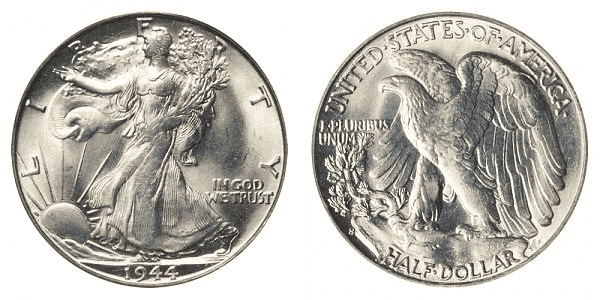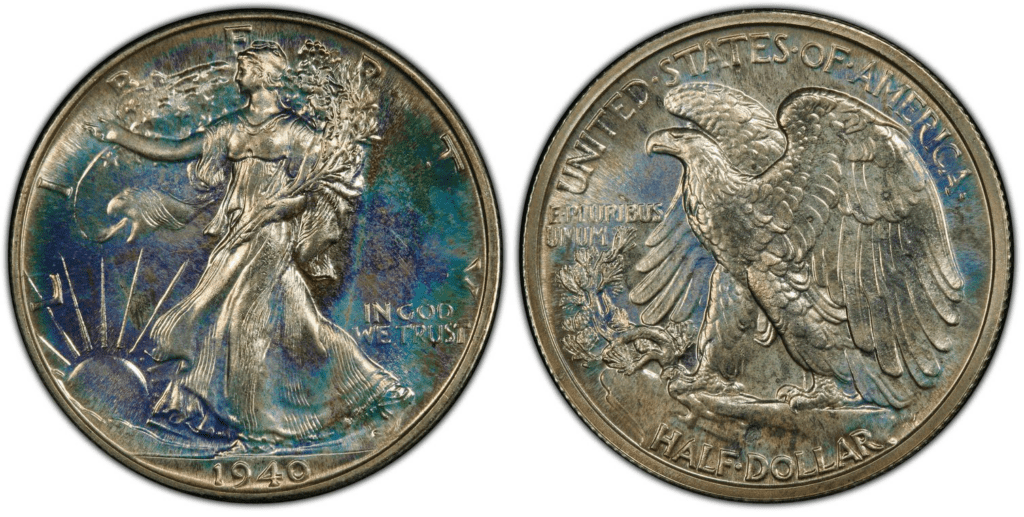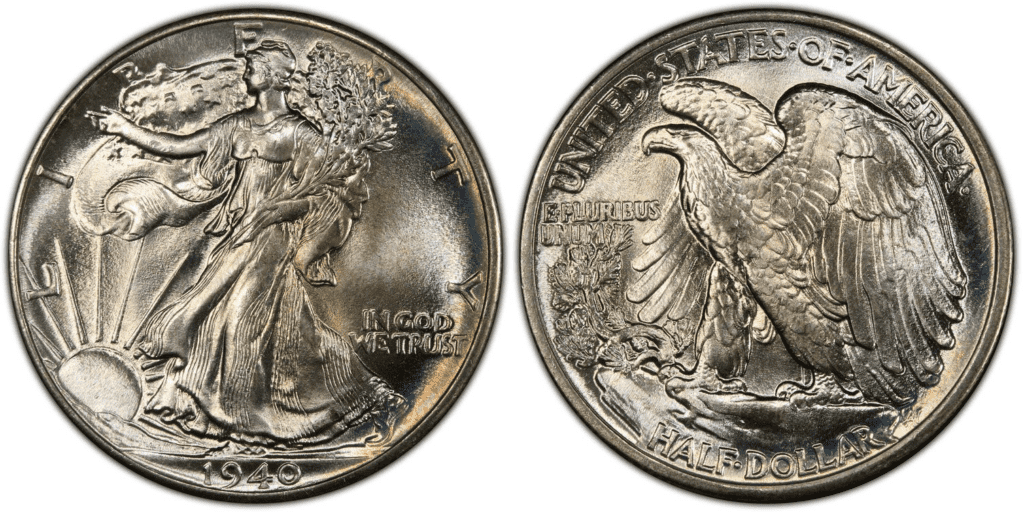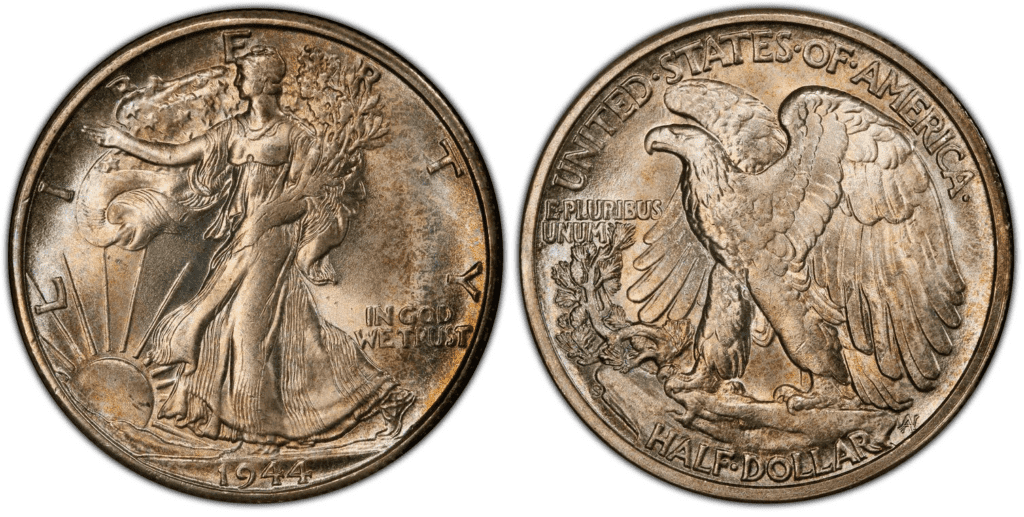What Is the 1940 Liberty Half Dollar Made Of?
One of the most beautiful silver coins ever produced by the United States is the Walking Liberty half dollar. Adolph A. Weinman, a renowned artist and engraver, created the Walking Liberty half dollar, produced from 1916 to 1947, and is now one of the most well-known coins ever.
The majority of Walking Liberty half dollars, which includes the 1940 50 cents, are common coins with a 90% silver and 10% copper composition. This coin has a diameter of 30.00 millimeters and weighs 12.50 grams.
The United States mints produced this silver half-dollar coin as part of their effort to make American coinage more attractive. The currency, created by renowned sculptor Adolph A. Weinman, portrays a walking Lady Liberty and an American Bald Eagle. The 1941 Half Dollar, as its name suggests, has a face value of fifty cents.

On one side of the coin, Lady Liberty is seen heading toward the sun, and on the other, the bald eagle of the United States is depicted perched atop a mountain. Above Lady Liberty’s head is the word LIBERTY, and below her is the year 1941. Behind her is the famous adage IN GOD WE TRUST.
The elegant reverse features an eagle holding a branch with a tiny pine seedling budding while its wings are spread defensively. Surrounding it are the words UNITED STATES OF AMERICA on top and the coin’s denomination HALF-DOLLAR below.
To the right is the Latin phrase E PLURIBUS UNUM, which translates to “out of many, one.” Pieces minted in Denver and San Francisco have small “D” or “S” mint marks below the pine sapling.
In his 1916 annual report, Treasury Secretary McAdoo described that the Liberty Lady’s striding towards the sun is a symbol of the United States’ constant progress. He further explained that the laurel and oak represent the military and civil glory of the country.
1940 Liberty Half Dollar Varieties
The 1940 walking Liberty half dollar coin is among today’s most sought-after coins. The coin is already more than 80 years old. Thus, it holds a great numismatic value.
In 1940, there were only two varieties. The Denver Mint didn’t produce any half-dollar coins at this time. Here are the two varieties and their mintage figure:
| Variety | Mint location | Mintage |
| 1994 Proof | Philadelphia | 4,550,000 |
| 1944-S | San Francisco | 11,279 |
| 1944-P | Philadelphia | 9,156,000 |
| Total | 13,717,279 |
Aside from those usual varieties, the mint centers also produced some error coins.
Here are some important details you need to know about the 1940 walking Liberty half-dollars.
1940 Proof Walking Liberty Half Dollar
Edge: Reeded
Mint Mark: none
Place of minting: Philadelphia
Year of minting: 1940
Face Value: $0.50 (fifty cents)
Price: $14 to $192 (or more)
Quantity produced: 11,279
Designer: Adolph Alexander Weinman
Composition: 90% silver and 10% copper
Mass: 2.50 grams
Diameter: 30.63 millimeters

The 1940 Liberty proof half-dollar is among the favorite coins among collectors. You should be able to find some deep mirror and beautiful Gems. However, these examples are rarer than coins from 1941 to 1942. Regrettably, no 1940-proof half-dollar coin has been seen to have a cameo and deep cameo rating.
1940 P Walking Liberty Half Dollar
Edge: Reeded
Mint Mark: No mint mark
Place of minting: Philadelphia
Year of minting: 1940
Face Value: $0.50 (fifty cents)
Price: $14 to $24 (or more)
Quantity produced: 9,156,000
Designer: Adolph Alexander Weinman
Composition: 90% silver and 10% copper
Mass: 2.50 grams
Diameter: 30.63 millimeters
Thickness: 1.80 millimeters

The 1940 half-dollar from the Philadelphia Mint is considered the rarest walking Liberty 50-cent coin from the ones struck in the 1940s.
Nevertheless, you should still be able to find nice examples. There are many 1940-P half dollars in Superb Gem conditions. These coins feature an impressive iridescent light color with slight gold toning and, sometimes, white luster.
The price range of the 1940 half-dollar may start from $14 to $24. At the end of 1940, the Philadelphia Mint produced more than 9 million half-dollar coins.
1940 S Walking Liberty Half Dollar Proof
Edge: Reeded
Mint Mark: S
Place of minting: San Francisco
Year of minting: 1940
Face Value: $0.50 (fifty cents)
Price: $14 to $39 (or more)
Quantity produced: 4,550,000
Designer: Adolph Alexander Weinman
Composition: 90% silver and 10% copper
Mass: 2.50 grams
Diameter: 30.00 millimeters

The San Francisco Mint helped the Philadelphia Mint in producing half dollars. The mint issued more than 4.5 million of them. It is worth noting that the 1940-S is the rarest walking Liberty variety of the 1940s, both in Gem and uncirculated condition.
List Of 1944 Walking Liberty Half Dollar Errors
A total of more than 13 million half-dollar coins were struck in 1940. With a low mintage like this, there were fewer moments when an error coin was made.
Nevertheless, the most common reason for this series to have error coins would be due to mechanical errors. For example, the coins made in San Francisco were known for weak strikes. The strikes were so weak that the hands and legs of Lady Liberty weren’t too detailed. Many numismatics even use the phrase “flat as a pancake” to describe this coin type.
How Much Is the 1940 Liberty Half Dollar Worth Today?
The 1940 Liberty half dollar has a face value of 50 cents. Its melt value is around $8.5541. The melt value can go up and down depending on the market value of silver.
You might think the 1940 Liberty half dollar is not worth your time, money, and effort. However, don’t be deceived because its true value can be astronomically more than its face or melt value.
To understand its value, check out this 1940 Liberty Half Dollar values chart:
| Coin | Condition | Grade | Mintage | Value |
| 1940 Proof Liberty Half Dollar | About Uncirculated | AU-55 to AU-58 | 11,279 | $145 to $192 |
| 1940 Proof Liberty Half Dollar | Uncirculated | PR-60 to PR-62 | 11,279 | $297 to $329 |
| 1940 Proof Liberty Half Dollar | Select Uncirculated | PR-63 | 11,279 | $312 to $429 |
| 1940 Proof Liberty Half Dollar | Choice Uncirculated | PR-64 | 11,279 | $312 to $505 |
| 1940 Proof Liberty Half Dollar | Gem Uncirculated | PR-65 to PR-66 | 11,279 | $575 to $408 |
| 1940 Proof Liberty Half Dollar | Superb Gem Uncirculated | PR-67 to PR-68 | 11,279 | $750 to $1,293 |
| 1940 S Mercury Dime | About Uncirculated | AU-58 | 4,550,000 | $35 to $75 |
| 1940 S Mercury Dime | Uncirculated | MS-60 to MS-62 | 4,550,000 | $42 to $186 |
| 1940 S Mercury Dime | Select Uncirculated | MS-63 | 4,550,000 | $58 to $135 |
| 1940 S Mercury Dime | Choice Uncirculated | MS-64 | 4,550,000 | $113 to $192 |
| 1940 S Mercury Dime | Gem Uncirculated | MS-65 to MS-66 | 4,550,000 | $275 to $430 |
| 1940 S Mercury Dime | Superb Gem Uncirculated | MS-67 to MS-68 | 4,550,000 | $4,560 to $27,025 |
| 1940 P Liberty Half Dollar | About Uncirculated | AU-58 | 9,156,000 | $25 to $41 |
| 1940 P Liberty Half Dollar | Uncirculated | MS-61 to MS-62 | 9,156,000 | $28 to $207 |
| 1940 P Liberty Half Dollar | Select Uncirculated | MS-63 | 9,156,000 | $39 to $71 |
| 1940 P Liberty Half Dollar | Choice Uncirculated | MS-64 | 9,156,000 | $110 to $222 |
| 1940 P Liberty Half Dollar | Gem Uncirculated | MS-65 to MS-66 | 9,156,000 | $91 to $456 |
| 1940 P Liberty Half Dollar | Superb Gem Uncirculated | MS-67 to MS-68 | 9,156,000 | $360 to $660 |
As you can see, the 1940 walking Liberty half dollar can be very valuable. Now, to be convinced, you need to see the auction records for each variety as listed on the website of PCGS:
- $35,250 – a 1940-S 50C (Regular Strike) coin with a grade of MS67 sold in April 2013 by Heritage Auctions
- $29,375 – a 1940 50C (Regular Strike) coin with a grade of MS68+ sold in September 2019 by Legend Rare Coin Auctions
- $19,200 – a 1940 50C (Proof) coin with a grade of PR68+ sold in June 2021 by Heritage Auctions
How Does The Grading System Work?
The Sheldon Scale is used by numismatists to provide a numerical value to coins. The Sheldon Scale goes from poor (P-1) to perfect mint state (P-1) (MS-70). Coins were originally evaluated using words to reflect their condition (Good, Fair, Excellent, Etc.). Unfortunately, coin collectors and dealers had different ideas about what each of these terms represent.
Professional numismatists joined together in the 1970s and established CoinGrading standards. These numismatists now assign grades at key places on the seventy-point scale, using the most regularly utilized numeric points in conjunction with the original adjective grade. The following are the most common coin grades:
-
-
- (P-1) Poor – Indistinguishable and probably damaged; if used, must have a date and mintmark; otherwise, rather battered.
- (FR-2) Fair – Nearly smooth, but without the damage that a coin graded Poor often possesses. The coin must have enough detail to be identified.
- (G-4) Fair – Inscriptions have merged into the rims in some areas, and important elements have been mostly erased.
- (VG-8) Very Good- A little weathered, but all of the primary design elements are visible, albeit faintly. There is little if any, central detail left.
- (F-12) Good – The item is very worn, yet the wear is even, and the overall design details stand out clearly. Rims are almost completely isolated from the field.
- (VF-20) Very Fine – Moderately weathered, with some finer features still visible. The motto or all letters of LIBERTY are readable. Both sides of the coin have entire rims that are separated from the field.
- (EF-40) Extremely Fine – Gently used; all gadgets are visible, and the most important ones are bold. The finer details are bold and clear, however, light wear may be seen.
- (AU-50) Uncirculated – Slight evidence of wear on the coin’s design’s high points; may have contact marks; eye appeal should be adequate.
- (AU-58) Uncirculated Choice – Slight traces of wear, no severe contact marks, almost full mint shine, and great eye appeal.
- (MS-60) Mint State Basal – Strictly uncirculated; no indication of wear on the coin’s highest points, but an unsightly coin with reduced luster, visible contact marks, hairlines, and other flaws.
- (MS-63) Mint State Acceptable – Uncirculated, but with contact scratches and nicks, little reduced shine, but otherwise appealing appearance. The strike is weak to average.
- (MS-65) Mint State Choice – Uncirculated with great mint shine, very little contact blemishes, and exceptional eye appeal. The strike is unusually severe.
- (MS-68) Mint State Premium Quality – Uncirculated with superb luster, no obvious contact marks to the naked eye, and exceptional eye appeal. The strike is quick and appealing.
- (MS-69) Almost Perfect Mint State – Uncirculated with perfect brilliance, a sharp and appealing strike, and extremely good eye appeal. A near-perfect coin with minor imperfections in the planchet, strike, and contact markings (seen only under 8x magnification).
- (MS-70) Mint State Perfect – Under 8x magnification, there are no tiny imperfections discernible; the strike is crisp, and the coin is perfectly centered on a beautiful planchet. Rarely seen on a coin, this coin is bright and whole, with original luster and exceptional eye appeal.
-
Where To Buy Or Sell 1940 Liberty Half Dollar?
The 1940 Liberty half dollar coins are available on Amazon, eBay, and other specialized websites. These platforms allow you to both buy and see coins. What’s more, is that you can create an account for free.
Moreover, you can visit coin shops, antique stores, and pawnshops. These are the usual places where you can find old coins, including the 1940 walking Liberty half-dollar.
If you have a 1940 fifty-cent, you can also sell that at an auction. Historically, some of the most expensive coins were sold in auction houses.
FAQs
Is a 1940 half dollar worth anything?
The 1940 half dollar is worth nothing if you just based it on its face value, which is 50 cents. However, its melt value is higher, which is about $8. If you have rare and mint-state coins, then you can sell that for a few hundred and even thousands of dollars in the open market.
Where is the mint mark on a 1940 half dollar?
The 1940 half dollar’s mint mark is on the coin’s reverse side. Look for it at the bottom left of the coin.
Is a 1940 half dollar silver?
Yes, the 1940 half dollar is made of silver. However, it’s not entirely made of silver. Only 90% is made of silver, while 10% is copper.
